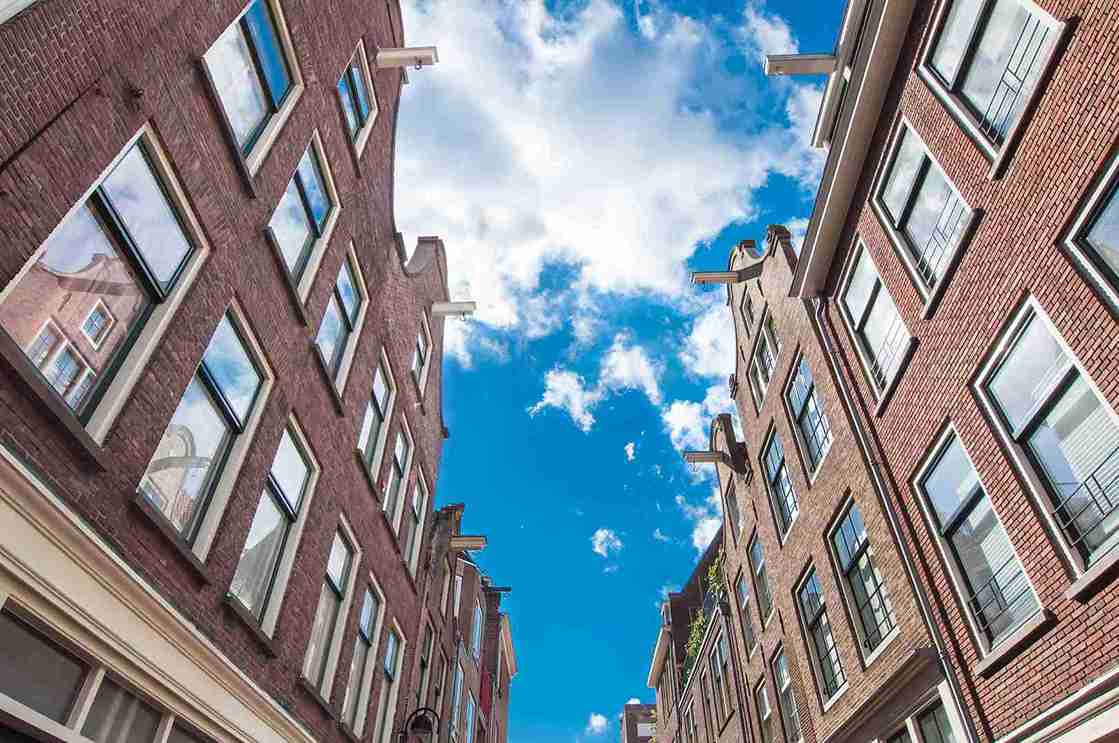
What is insulating glass?
Insulating glass includes all types of glass that insulate better than single glazing. In general, insulating glass consists of several layers of glass. In between there can be air (as with the first double glazing or Thermopane), gas (HR++ or triple glazing) or a vacuum (BENGglas®), and possibly a low-e coating. Although insulating glass often consists of two layers of glass, there is also a variant with three layers of glass: triple glass. This type of insulating glass is also equipped with a low-e coating.
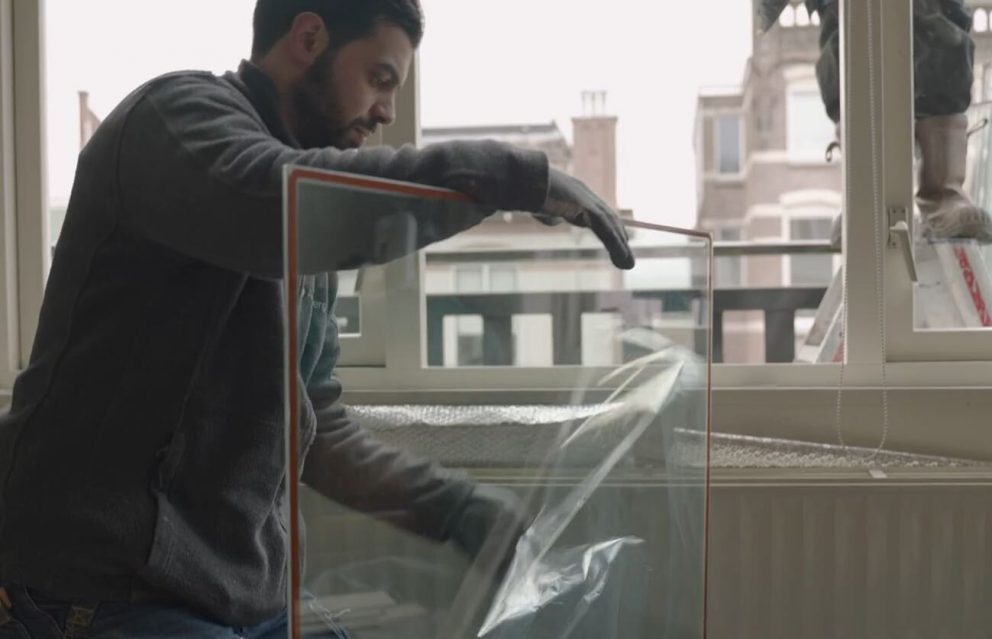
Invest smartly in insulating glass
Whether it concerns a home or business premises; a significant part of the building envelope consists of glass. The impact of poorly insulating glass is therefore very large: higher energy costs, less comfort and therefore living pleasure and productivity, and a larger ecological footprint.
Choosing glass with the best insulation value therefore means choosing an investment that pays for itself on all fronts. Double down. In addition, good insulating glass has positive consequences for the energy label and you are therefore more likely to comply with the BENG standard.
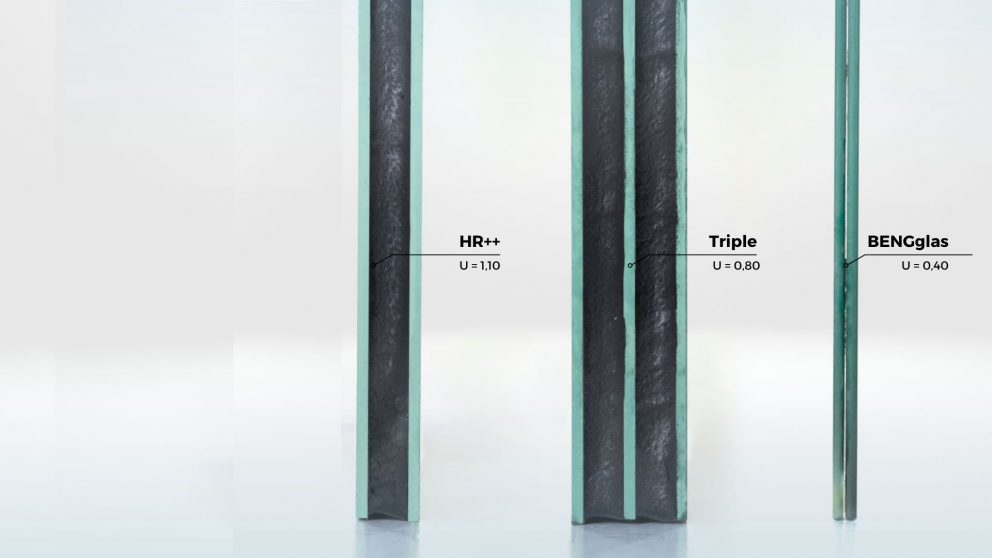
THE EVOLUTION OF INSULATING GLASS
Insulating glass includes all types of glass that provide better insulation than single glazing. As a rule, insulating glass consists of several layers of glass with air, gas or a vacuum in between. Although insulating glass often consists of two layers of glass, there are also variants with three layers of glass, known as triple glass.
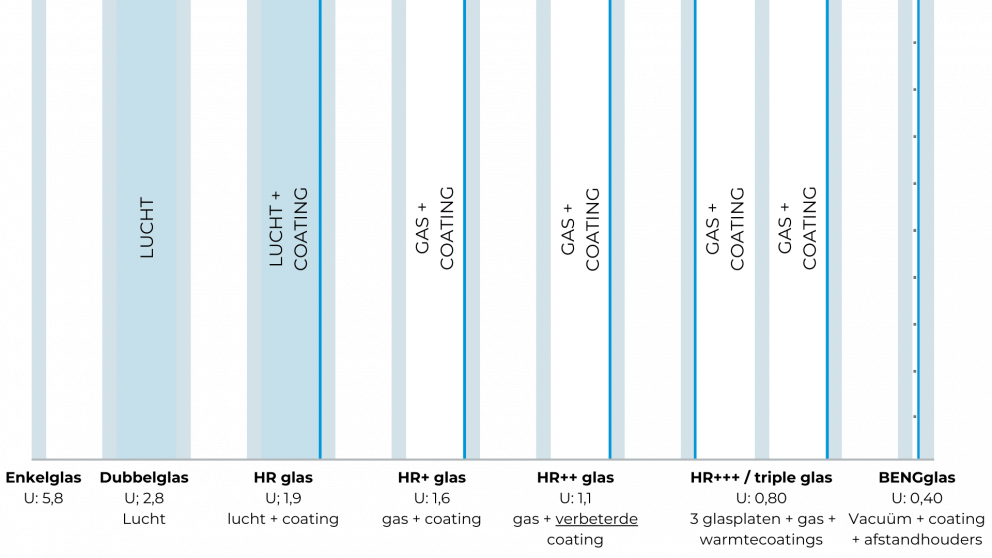
Type of insulating glass and U-value
Insulating glass is divided into three categories:
- Double glazing (Thermopane)
- High-efficiency insulating glass: HR, HR+, HR++ and HR+++ (triple glass)
- Vacuum glass ( Bengglas® )
Insulating glass U-value
The insulation value of insulating glass is expressed in a U-value. Do not confuse the U-value for insulating glass with the R-value for roof and wall insulation. Because the lower the U-value, the better the window insulates. This is exactly the opposite with the R-value.
Below we explain the different types of insulating glass.
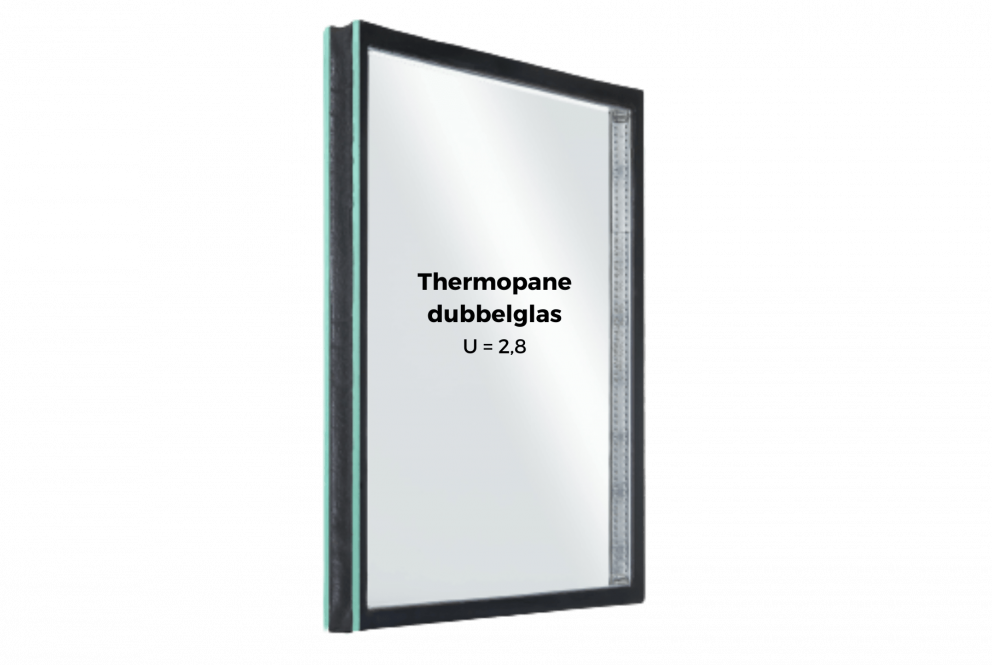
Double glazing
Standard double glazing (Thermopane)
Double glazing was the successor to single glazing and therefore the first insulating glass. You can still find this type of insulating glass in older buildings. Popularly, the old double glazing is also called Thermopane; to the first brand of this type of insulating glass.
Construction and construction
This first type of insulating glass consists of two panes of 4 to 5 mm thick with a cavity filled with air in between. Air conducts heat better than a gas filling or a vacuum, which means that the insulation value (U-value 2.8) is less good than other types of insulating glass.
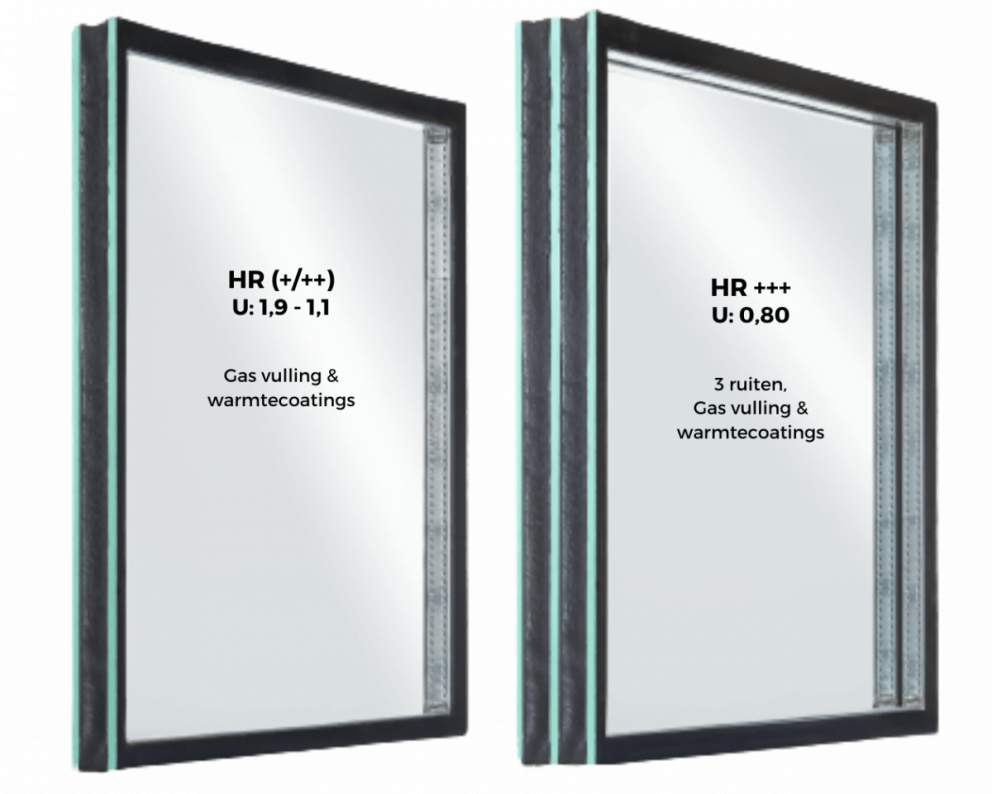
High-efficiency insulating glass (HR glass)
The next step after standard double glazing was high-efficiency insulating glass, better known as HR glass. By applying a heat coating that reflects heat back into the home, HR glass achieves a significantly lower U value: 1.9. When the air filling was replaced by a gas filling, the U-value was further improved (1.6) and HR+ glass was introduced.
But that was far from the end of the development of insulating glass. Because then HR++ glass came onto the market (windows with an improved coating and U-value of 1.1) and later HR+++ or triple glass, which achieves a U-value of 0.8. The insulation value of insulating glass has been improved step by step.
Advantages and disadvantages of high-efficiency insulating glass
HR++/+++ glass insulates considerably better than the old double glazing. However, a major disadvantage is that HR glazing is quite heavy and, above all, thick. As a result, this type of insulating glass does not always fit into the existing window frames, resulting in the need to replace both window frames and hinges and locks. In short: a lot of work and high costs.
In addition, even the best high-efficiency insulating glass (HR+++ glass) cannot compete with the very latest insulating glass: vacuum glass or BENGglas®. This latest innovation achieves a U-value that is even better (maximum 0.4). Moreover, the U-value of vacuum glass remains the same all the time.
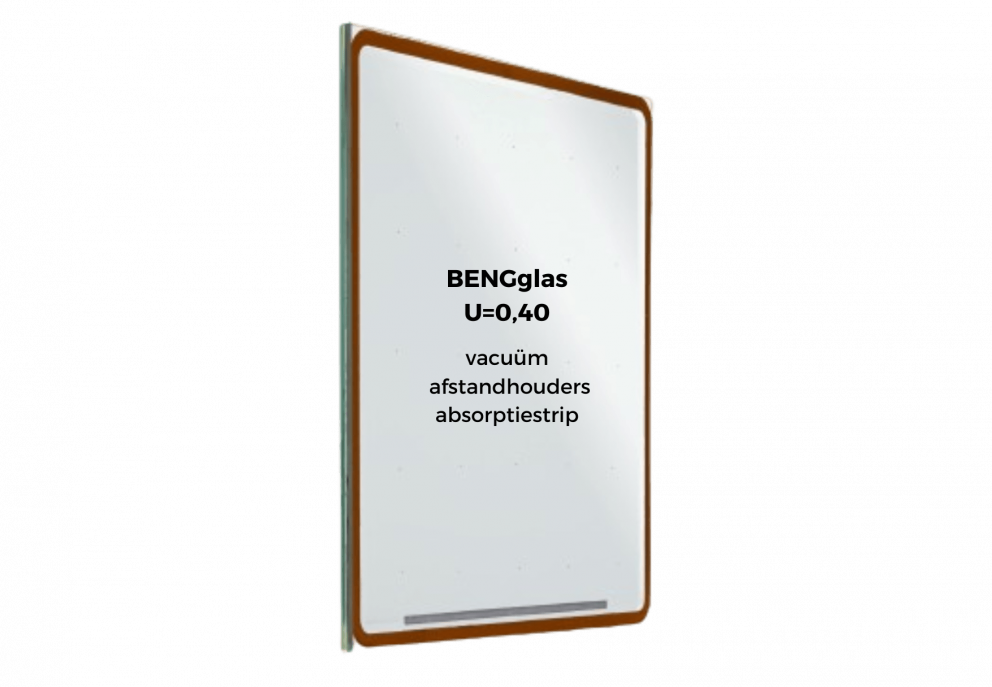
Vacuum insulating glass
Bengglas® is the final step in the development of insulating glass. By not applying air or gas, but a vacuum between the two windows, the heat supervision is kept to a minimum.
+ Comfortable and quiet living
+ Ultra-thin, so window frames, hinges and locks are preserved
+ Longer lifespan
+ 15% more natural light compared to triple glazing
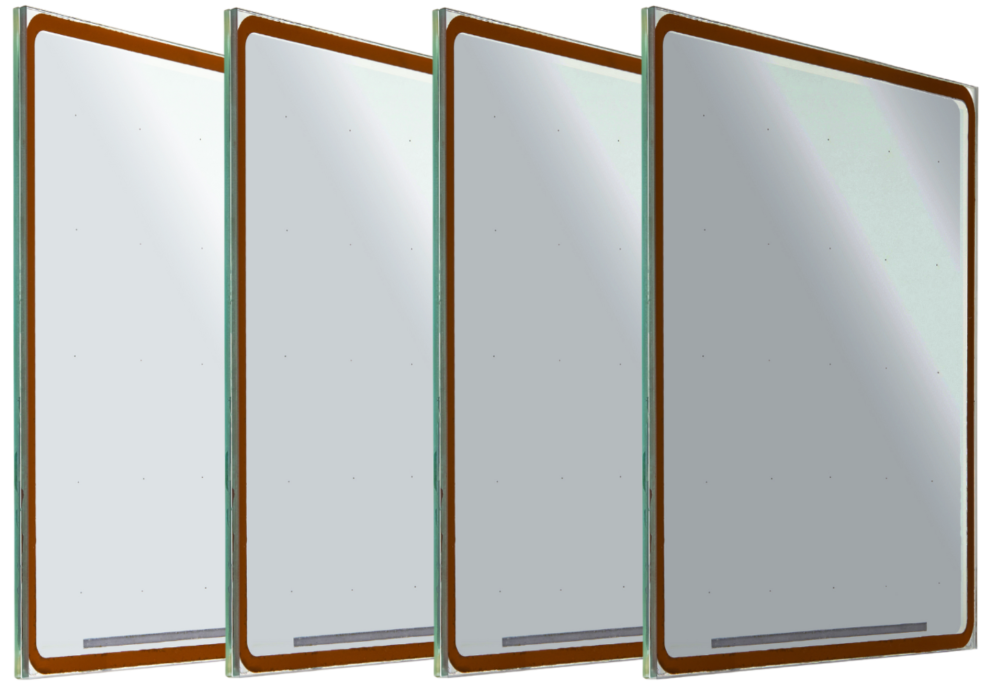
Characteristics of vacuum insulating glass
Vacuum glass has tiny spacers in the glass. It also contains an absorption strip, which can be installed behind the glazing beads. Our insulating glass does not have a vacuum cap, because we vacuum through the edges - which is very convenient. We will take you through the most important external features of this type of insulating glass, so that you know what you are choosing.
Spacers
Spacers are tiny pillars between the two glass plates. These distribute the pressure over the glass surface and prevent the glass plates from breaking. The spacers are located every 40 to 60 mm (depending on the type) and are barely visible. Our dealers always have a product sample, so that you can experience the glass with your own eyes.
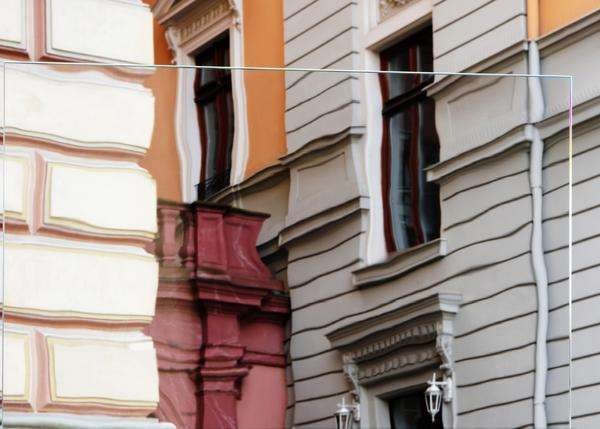
Order options for insulating glass
By coatings, films, extra windows or other post -processing you can provide insulating glass with extra (powerful) properties, think: burglar -resistant, fall -free, fire -resistant, sound -insulating, sun -resistant and even a monumental 'wavy' look. Such post -operations are also all possible with Bengglas®. Get advice before your insulating glass will order.
Inquire about the possibilities by emailing info@bengproducts.nl or consult a dealer near you.
The advantages of insulating glass at a glance
HR++, triple or vacuum glass are a logical choice for making old homes and business premises more sustainable. However, by choosing vacuum glass you also save the costs of new window frames and hinges and locks. But the best thing is of course that you start saving energy immediately. Moreover, the insulation value of vacuum insulating glass remains stable for longer (25 to 50 years) than that of high-efficiency glass (20 to 40 years).
Price of insulating glass
vacuum glass is more expensive than HR ++/+++ glass, but the benefits weigh heavier than the costs. After all, you save a lot of material (frames, hinges and locks), benefit from the highest insulation value and thus save energy costs, while the appearance of your building remains intact. That is why it is smart to not only look at the purchase price, but also at the value increase, savings and practical benefits that this type of insulating glass entails. Therefore always request a free cost comparison with one of the Bengglas® dealers to make a well-considered choice.
- ABOUT INSULATING GLASS
Glass was invented accidentally by heating glass grains in sand to create glass beads. These pearls were originally worked for beads, but later crafted into larger shapes from 1,500 BC. The Romans invented the casting process around the first century AD and made it possible to produce the first "flat glass". The glass was not really transparent. And due to the lack of lime, these windows were still very vulnerable.
Around the Middle Ages (approximately 1,000 AD), production techniques were significantly improved and it became possible to produce clear glass using coal and advanced furnaces.
As a result, quality increased and the existence of the first large glass concerns began.
In the following centuries, the techniques and compositions of glass were greatly improved and the possibilities with glass are now endless.
There are different types of insulating glass available, each with its own properties and applications. Some of the most common types of insulating glass are:
- Double glazing or Thermopane: This is the most common type of insulating glass and consists of two glass panels with an air space (cavity) between them. The air space may be filled with air or an insulating gas such as argon or krypton. It is commonly used in homes and commercial buildings. Air conducts better than noble gas, which does not improve insulation performance. Small cracks can develop in the edge seal, causing the insulation performance to decrease over the years.
- High-efficiency glass: HR++ and HR+++ (also called triple glass) is double glazing with a coating and insulating glass between the glass plates. This achieves better insulation. HR+++ (also called triple glass) achieves better insulation performance than HR++ because the construction consists of three glass plates. Small cracks can develop in the edge seal of both types, causing the insulation performance to decrease over the years.
- Vacuum glass : This type of glass consists of two thin layers of glass that are hermetically sealed so that virtually no heat loss can occur. In a vacuum, virtually no (heat) conduction can take place. What is heated indoors retains its heat. The heat from outside also stays outside. It offers the best thermal insulation of all types of insulating glass and retains its insulation value compared to traditional insulating glass due to the advanced edge seal.
The choice of the right type of insulating glass depends on the specific needs. Additional functions can also be assigned to the glass with additional films or coatings. Consider functions such as: sun-resistant, fire-resistant, burglar-resistant or, for example, extra sound insulation. Such applications are possible with BENGglas®. Complete the contact form to request the options.
Traditional insulating glass (HR++, HR or triple glass) has a lifespan of approximately 15 to 30 years, but gradually loses its insulation value due to cracks in the sealing edge. For comparison: the expected lifespan of BENGglas® is between 25 -50 years (or even longer), while retaining its insulation value.
It is important to note that the lifespan of insulating glass can vary depending on conditions and maintenance. Regular maintenance and careful installation can extend the life of all types of insulating glass.
BENGglas® has a warranty period of 15 years. Traditional insulating glass has a warranty period of 10 years.
HR++/+++ glass offers significantly better insulation compared to standard double glazing. However, it quickly becomes thick and heavy, making it unsuitable for existing window frames and hinges and locks. It is often necessary to replace both the glass and the window frames, which can lead to significant costs.
In addition, the insulation value cannot compete with vacuum glass (U=0.40), and over time this value slowly increases with HR++/+++ glass due to cracks in the frame. This problem does not occur with vacuum glass. In addition, the lifespan of HR++/+++ glass is shorter than that of vacuum glass (20-40 years compared to 25-50 years).
vacuum glass is more expensive to purchase than HR++ or triple glass, but the value of the glass goes directly into improving your energy label and saving materials. That is why it is not smart to only look at the base price, but to take into account potential increases in value and savings. Therefore, always request a no-obligation cost comparison from one of the BENGglas® dealers to make a well-considered choice.
Request a quote immediately!
Request a quote and we will forward it to a dealer in your area, that's easy. If you have any questions, you can also contact us, we are ready to help you.
